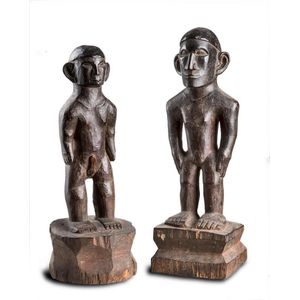Kylin Bronze Censer with Pierced Cover and Feet
You must be a subscriber, and be logged in to view price and dealer details.
Subscribe Now to view actual auction price for this item
When you subscribe, you have the option of setting the currency in which to display prices to $Au, $US, $NZ or Stg.
- Bronze - An alloy of copper and tin, traditionally in the proportions of about 9 parts of copper to 1 part of tin.
The discovery of bronze in Western Asia in the 4th century enabled people to create metal objects which were superior to those previoulsy possible because of its strength and hardness, and it has been used throughout the world for weapons, coins, tools, statuary and other decorative items.
It is very fluid in a molten state, and its hardness, strength when set, and non-corrosive properties makes it most suitable for casting sculpture. - Finial - An architectural decoration, found on the upper parts of of an object. On furniture they are usually found on pediments, canopies and shelf supports. On smaller ceramic or silver items, such as spoons, they may decorate the top of the item itself, or the lid or cover where they provide a useful handle for removal.
Finials have a variety of shapes and forms. They may be urn-shaped, baluster shaped round or spiral, but usually taper into an upper point. Many real life shapes may also be used as finials, such as pineapples, berries, pinecones, buds, lotus and acorns. Sometimes animals such as a lion are depicted, or fish and dolphins. - Kylin or Qilin - A kylin or qilin is a mythical Chinese animal, dating back to the 5th century with the head of a dragon, the body of a deer and the tail of a lion. It is a regarded as a good omen bringing serenity and prosperity, and is said to appear with the coming or departure of a wise sage or illustrious ruler.
It is also part of the culture of Korea and Japan.
As well as being represented in bronze and jade, it is also used as a decorative motif on ceramics.
This item has been included into following indexes:
Visually similar items

Bronze Buddha traditional stance on lotus plinth, 39 cm height

A Pair of Standing Bululs, Kababuyan Village, Ifugao, Philippines, (circa 1900), carved hardwood, 42 cm; 38.7 cm high (2). Provenance: William Beyer, Manila. Acquired from above by Dr Peter Elliott in the late 1960s. These highly stylized figures are the w

French school (19th century) the figure of a Greek goddess leaning on a column supporting a clock bronzed spelter on slate base clock movement initialled ELR stamped Japy Freres & Cie Grd Med. D'Honneur 60 x 27 x 73 cm

A Chinese brass censer, 20th century with Foo dog decoration to lid & three feet, height 16 cm
